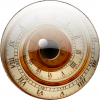 Re: What adjustments are necessary to match printing to monitor display?
Re: What adjustments are necessary to match printing to monitor display?
Hold on, Bill stated that it is only an approx. of your actual output, there are two or three other methods I use! I tend to have quite a restricted palette that I use and I save it as a template and with those colours all displayed I get a wet copy of how they look printed so see what they actual look like when done in CMYK and I also print there values next to the colours. Next I always tick "View PDF when finished" as it also shows how dull the colours can be as they darker colours will all look washed out. After you have done a few print jobs, with the fist few I would always get a wet copy of your work, as your experience grows you will need less and less wet copies.
If you have a bitmap editor most will allow you to look at an RGB type file .png or .jpeg if you are going to use it in you Xara doc. and see the out of gamut areas which you have to rectify before importing it into Xara.
Design is thinking made visual.





 Reply With Quote
Reply With Quote









Bookmarks